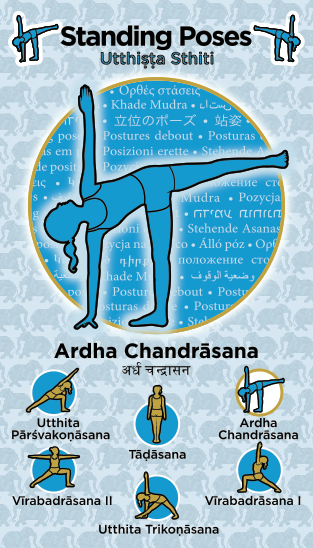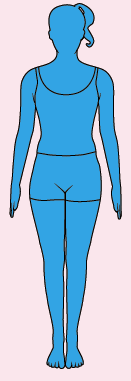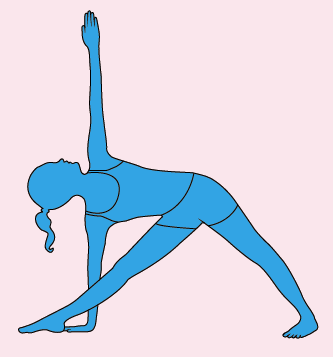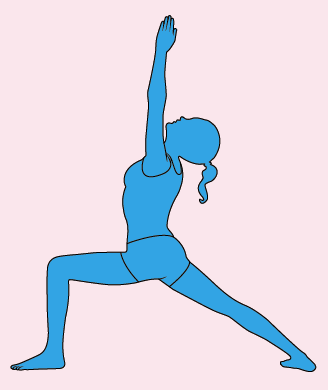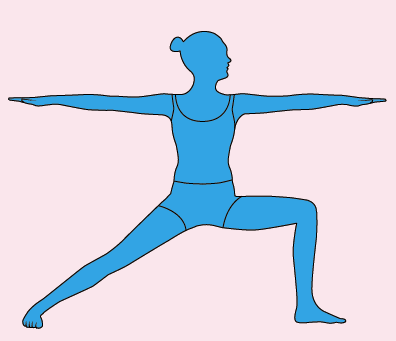YOGA ASANAS :
“STANDING POSES” FAMILY
each of the six Asanas is featured using the same design.

Ardha chandrāsana
# 10, plates 18/19, page 74 ( «Light on Yoga» BKS. Iyengar. Aquarian/Thorsons. Harper Collins India. Schocken books, New York).
# 8, plates 10, page 130 ( Yoga a gem for women, Geeta s.Iyengar, allied publisher 2002 ).
Not featured in (« The illustrated light on Yoga » BKS Iyengar. Aquarian/Thorsons & Harper Collins India ).
Ardha: Half, still in use in modern India.
Chandra : La Lune, qui est masculine pour les indiens. C’est d’ailleurs un prénom masculin répandu en Inde.
This is the half moon pose.
.
Tāḍāsana/Samasthiti
# 1, plate 1, page 61 ( «Light on Yoga» BKS. Iyengar. Aquarian/Thorsons. HarperCollins India. Schocken books, New York ).
# 1, plate 1, page 41 (« The illustrated light on Yoga » BKS Iyengar. Aquarian/Thorsons & Harper Collins India ).
# 1, plate 1, page 121 ( Yoga a gem for women, Geeta s.Iyengar, allied publisher 2002 )
This āsana goes by two names: Tāḍāsana and Samasthiti.
Tāḍa: Mountain.
Sama: Upright, straight, unmoved.
Sthiti : To stand firm and erect as a mountain.
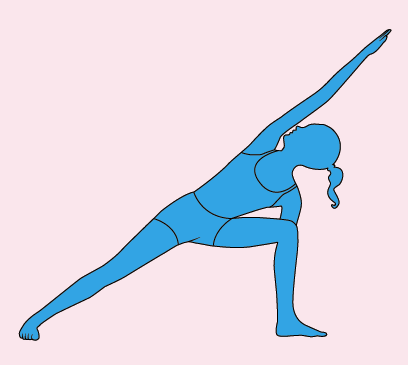
Utthita pārśvakoṇāsana
# 5, plates 8/9, page 66 ( «Light on Yoga» BKS. Iyengar. Aquarian/Thorsons. Harper Collins India. Schocken books, New York).
# 3, plates 5/6, page 43 («The illustrated light on Yoga» BKS Iyengar. Aquarian/Thorsons & HarperCollins India ).
# 4, plate 5, page 124 ( «Yoga a gem for women», Geeta s.Iyengar, allied publisher 2002 )
Utthita: Extended with intensity.
Pārśva: Side, flank.
Koṇa: Angle.
.
Utthita Trikoṇāsana
# 3, plates 4/5, page 64 («Light on Yoga» BKS. Iyengar. Aquarian/Thorsons. Harper Collins India. Schocken books, New York).
# 2, plates 2/4, page 42 («The illustrated light on Yoga» BKS Iyengar. Aquarian/Thorsons & HarperCollins India ).
Pages 22/23 («Yoga the Iyengar way». S,M & S Mehta. Dorling Kindesley, London).
Pages 50/55 («Yoga, the path to holistic health», Dorling Kindesley, London).
# 3, plate 4, page 122 ( Yoga a gem for women, Geeta s.Iyengar, allied publisher 2002 )
Utthita: Extended with intensity . Tri: Three. Koṇa: Angle.
Three angles or triangle: The whole body is shaped after a triangle. The legs with the ground and the floor, the arms with the legs. The number 3 leads us to the Trimūrthi: Brahma the creator, Viṣṇu who perpetuates and protects the universe, and Śiva who destroys and allows changing. Those three deities are the three aspects of a single reality. These three aspects can be found again in the Trigunas: Rajas/active. Sattva/balanced, luminescent, pure. Tamas, sign of inertia. In indian medecine, or Ayurveda, the Triogunas are evaluated to make a diagnostic. – The zodiac is rythmed by the combination of these three qualities (cardinal, fix, mutable) with the sequencing of the four elements. Aries is fire/cardinal (Starting energy, creation ), Leo is fire/Fix ( generous and superb, center of the universe… ), and sagittarius is fire/Mutable. #3 Plates 4/5, page 64 ( “Light on Yoga” BKS. Iyengar. Aquarian/Thorsons. HarperCollins India. Schocken books, New York). #2 Plates 2/4, page 42 (“ The illustrated light on Yoga ” BKS Iyengar. Aquarian/Thorsons & HarperCollins India ).
Links to Trikoṇāsana:
– Trikoṇāsana with Dr. Geeta Iyengar (26 minutes)
.
Vîrabhadrãsana 1
# 7, plate 14, page 69 ( «Light on Yoga» BKS. Iyengar. Aquarian/Thorsons. Harper Collins India. Schocken books, New York).
# 5, plates 7/9, page 44 (« The illustrated light on Yoga » BKS Iyengar. Aquarian/Thorsons & Harper Collins India ).
# 5, plate 7, page 125 ( Yoga a gem for women, Geeta s.Iyengar, allied publisher 2002 ).
Vîrabhadrãsana 2
Vīra : heroe / Bhadra : friend
# 8, plate 15, page 72 ( “Light on Yoga” BKS. Iyengar. Aquarian/Thorsons. Harper Collins India. Schocken books, New York).
# 4, plates 10, page 45 (“ The illustrated light on Yoga ” BKS Iyengar. Aquarian/Thorsons & Harper Collins India ).
# 6, plate 8, page 127 ( Yoga a gem for women, Geeta s.Iyengar, allied publisher 2002 )
Vīrabhadra was a heroe from antique epics whose story is told by Kālidāsa in “ Kumāra Saṁbhava ” (“the birth of the war lord”). He rose up from a hair lord Śiva threw to the ground in great anger.
This story relates the love between Śiva and the princess Satī, image of the divine mother, daughter of the king Dakṣa, himself son of the lord Brahma.
Satī (from “sat”, or truth, which can be found in “Satya” dear to Patanjali) and Śiva lived for eons in an intense state of communion.
The king Daksha had never welcomed as a son this most unorthodox hermit who wanderered about on cremation sites. In no way could he aknowledge as worth of the royal blood that ran in his family this yogi with long matted hair, chanting and dancing whenever he felt like it, and who indulged in far from canonic rites. King Daksha had even distanced himself away from the princess Satī.
The king was about to perform a Yagna, a great ritual celebration, to which he had invited all members of the family, the allies, the gods, sages as well as the subects of the kingdom. Not only did he neglect to send word to both his daughter and her husband, but he had a great statue of Śiva erected, in front of which he marched mocking him.
The princess Satī nevertheless went to the premices where the sacrifice was being held. She had to stand her father taunts : “I see you are not out of your mind any more. For sure you must have had enough of this wild animal. Does he not go by the name of Lord of the cattle and creatures (Pashupati)” ?
Out of humiliation, Satī decided she would not have anything to do with her father no more, neither with her very own body she had received from him. She sat down with closed eyes, and immerged herself into a deep meditation upon the vision of Śiva, her very god. She went so far into her mystic and yogic transe as to set herself ablaze in a devastating fire.
At this terrible new Śiva tore one of his hair off and threw it to the ground. Out of this hair rose up the heroe Vīrabhadra ( Vīra – heroe + Bhadra – friend ), who drove Daksha’s armies to flee, then slayed Daksha head off and finally destroyed his Yajna, or sacrifice.
After his furry had calmed down, seing Vīrabhadra formidable slaughter, Śiva felt compassion. He brought Daksha back to life, and replaced his lost head with a goat’s head ( this changing of head being the symbol of the annihilation of Daksha’ego ). The grateful Daksha granted Śiva the title of Shankar : “ the one who is full of benevolence ”.
But Satī was nevertheless deceased. In terrible pain, Śiva picked up whatever remainded of her and wandered through worlds, continents and oceans causing considerable perturbations, without finding any relief. Gods found themselves helpless and called Vishnu to the rescue. He used his Sudarshana chakra, his special weapon, to split Satī lifeless body into 52 different pieces which fell scattered on different spots of the land of India, still named to this day “ Shakti peethas”. They are visited by pilgrims as “shrines of the Shakti”.
Śiva cried so much and for such a long time that his tears filled up two sacred ponds – one in Pushkar, Ajmer, and the other one in Ketasha, which literally means “rain of the eyes”.
At last Śiva sat by the source of the river Ganges, at the very spot where he had so long ago received the river Ganges onto his matted hair, so that the impact of this fall ( the river Ganges is the galaxy/milky way descended on earth ) would not destroy our world.
Then out of a deep meditation, he remembered who he really was, he remembered the divine Mother and the sacred wow they had made to never part, even if the physical body was there no more, and that it was in the way of things that all things pass and change, that the body deasapears and that the Divine Mother stays dormant for a while.
She would come back to him, eons later, as Parvati, the daughter of the Himalayas to start a new story up to the end of times, as it had always been since the beginning of the ages.
The myth of Satī in modern literature
As soon as the procession had disappeared, Phileas Fogg asked the Brigadier-General: “A suttee”? “A suttee is a human sacrifice, but a voluntary one. The woman you have just seen will be burned at daybreak”. In Around the the earth in 80 days. Jules Verne
Liens pour Virabhadrasana II
1/ http://www.sacred-texts. com/hin/sha/sha16.htm.
2/ ( Pashupati (पशुपति) désigne dans l’hindouisme le dieu Śiva, sous la forme du “Maître des créatures” ou du “Maître du troupeau”. Il est une des formes les plus anciennes de Śiva ). Les humains sont considérés comme le “bétail des dieux”. Alain Daniélou a repris cette appellation pour un recueil de contes, par ailleurs controversés ).https://fr.wikipedia.org/wiki/ Pashupati
2/ bis: http://www.mohenjodaro.net
3/ https://en.wikipedia.org/wiki/ Sudarshana_Chakra )
4/ https://fr.wikipedia.org/wiki/ Sati –
